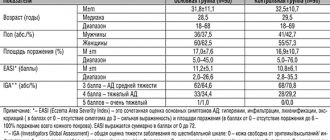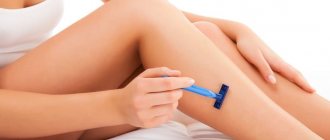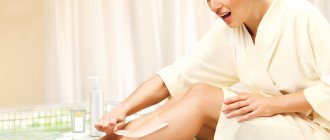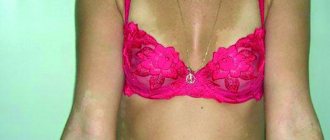The appearance of dubious spots on the skin, which sometimes itch and flake, is a serious reason to consult a doctor and check for dermatological diseases.
Pityriasis rosea (Giber's disease, roseola exfoliates, pityriasis, pithiasis) is an acute skin disease with specific rashes, a peculiar course and a tendency to seasonal relapses. It manifests itself in the formation of pink spots on the skin of the chest, back, limbs and other parts of the body, located along the lines of maximum extensibility (Langer's lines). Over time, the rashes become like large medallions. From the moment the first maternal plaque (large spot) is detected until the symptoms of the disease completely disappear, 30-45 days pass.
At CELT you can consult a dermatologist.
- Initial consultation – 3,500
- Repeated consultation – 2,300
Make an appointment
Causes of pityriasis
Despite the fact that Gibert's disease is very common, the mechanism of the disease is not fully understood. The following factors are believed to play an initial role:
- Exposure to viruses (type 7 herpesvirus, etc.), bacteria and other infectious agents. This is confirmed by tests that prove the presence of pathogens in the body. Very often, skin disease appears against the background of influenza, acute respiratory infections and other infections.
- Attachment of allergic reactions.
- Bites from bedbugs, lice and other blood-sucking insects.
- Reduced immune defense.
- Frequent hypothermia and stress.
- Violation of gastrointestinal functions and metabolism.
- Introduction of vaccines.
Contraindications and side effects
Do not use ointment or cream if you have hypersensitivity to the ingredients in the composition. Also, external agents are contraindicated in the first trimester of pregnancy (there is insufficient data on the safety of clotrimazole).
After applying the ointment or cream, symptoms of an allergic reaction may occur: redness, irritation, itching. Rashes and severe peeling appear less frequently. In most cases, such effects are caused by fungal toxins, the cells of which are destroyed by the active substance of the drug. Most often, side effects disappear with further treatment. If the negative effect persists or intensifies, then therapy with this drug must be interrupted.
No health hazards have been reported with long-term use of Clotrimazole ointment.
The active ingredient of the drug interacts with a number of other antifungal agents. Nystatin and natamycin reduce the effect of clotrimazole.
Combined use with dexamethasone gives the same result. The antimycotic effect of clotrimazole is enhanced in the presence of the additive E216, used in cosmetics and food products as a preservative and antifungal agent.
Symptoms of pityriasis
Clinical manifestations of pityriasis rosea are caused by exposure to infectious pathogens and the development of allergic reactions. The skin disease is manifested by the following symptoms:
- General weakness, enlarged lymph nodes, elevated body temperature.
- The formation on the body of small pinkish and mauve spots that have a symmetrical shape and appear along Langer’s lines. Rashes appear on the back, limbs, chest, neck, groin and other parts of the body.
- The appearance on the skin of 2-3 bright red maternal plaques (their diameter is 4 cm), dotted with scales. After a week, small pink rashes form from these large spots.
- Dropout spots spread throughout the body and increase in size (their diameter is 1-2 cm), can peel off, and resemble medallions in shape.
- Severe skin itching.
- Increased irritability.
With proper therapy, the symptoms of pityriasis disappear after 5-8 weeks, and the patient fully recovers. Longer therapy is required if the rash has dense nodules, blisters or papules. In exceptional cases, pityriasis rosea turns into eczema, purulent inflammation of the skin, folliculitis, streptococcal infections, etc. develop. The development of complications is facilitated by the patient’s excessive sweating, a tendency to allergies, constant friction of the skin and improper treatment.
Overdose
Symptoms of overdose include erythema, tingling, blistering, peeling, swelling, itching, urticaria, burning and general skin irritation, and cramps. As with all topical medications, skin sensitization may occur.
Clotrimazole does not pose a risk of acute toxicity as it is unlikely to occur after a single vaginal or cutaneous application. Overdose when applied is possible over a large area under conditions favorable for absorption, or accidental oral administration. There is no specific antidote.
Diagnosis of pityriasis
If you find suspicious spots on the skin, you should promptly contact a dermatologist. During a visual examination, the doctor assesses the nature of the rashes, their shape, size, location on the body and is able to make the correct diagnosis. After dermatoscopy, the following studies are additionally carried out: biochemical tests of blood and urine, RMP (microprecipitation reactions with antigens), skin scrapings from injured areas.
A more complex diagnosis is carried out if the skin disease lasts more than six weeks. In these cases, discharge from the affected lesions is sent for bacterial culture. A biopsy and subsequent histological studies will help make the correct diagnosis. In order to distinguish Zhiber's disease from other types of lichen, toxicerma, psoriasis, complicated syphilis and other pathologies, fluorescent diagnostics are carried out, scrapings are checked for the presence of pathogenic fungi, RPR tests are done for syphilis, etc.
The therapeutic effect of clotrimazole
The skin and mucous membranes are affected by various species and strains of microscopic fungi belonging to the group of dermatophytes. They feed on keratin in the epidermis, nails and hair. The genera Epidermophyton, Trichophyton, Microsporum, and representatives of the genus Candida have pathogenic properties. The latter cause thrush and affect the skin and internal organs of a person. Yeast-like microorganisms of the genus Malassezia cause pityriasis versicolor (pityriasis versicolor).
Action of clotrimazole:
- antifungal
- against Trichophyton rubrum, Epidermophyton, Microsporum, Candida albicans, Malassezia folliculitis; - antiprotozoal
, mainly trichomonacid, - the ability to suppress the causative agent of trichomoniasis (the simplest organism Trichomonas); - antibacterial
- against strains of bacteria staphylococci and streptococci.
The fungistatic effect of clotrimazole is expressed in growth retardation and reduction in the reproduction of microscopic fungi, which ultimately leads to their death. Fungicidal effect - suppression of the germination of parasite spores in the skin, nails, mucous membrane, which completely blocks the development of infection. What effect will be achieved depends on the type and strain of the microbe, the concentration of the active ingredient.
Resistance is rarely developed in fungi against which clotrimazole is used.
The causative agents of mycoses parasitize in the upper layer of the skin. Clotrimazole acts on microorganisms directly at the site of the lesion. The medicine penetrates the epidermis, but is not absorbed into the blood through the skin. If the active substance enters the systemic bloodstream, it is destroyed in the liver. Decomposition products are excreted through the gastrointestinal tract and kidneys.
Pityriasis rosea in pregnant women
Pityriasis occurs more often in women than in men. It is especially dangerous when the skin disease occurs in pregnant women. If you notice any rashes, it is important to immediately visit a dermatologist and undergo treatment. It is unacceptable to risk the baby’s health and expect the plaques to disappear on their own. If the disease is not treated, then bacterial infections appear, which are much more difficult to deal with.
If a pregnant woman has not been diagnosed with pityriasis rosea, it is nevertheless important to adhere to the following recommendations:
- clothing made from cotton and linen is preferable to synthetic and woolen fabrics
- limiting heavy physical activity
- For hygienic purposes, use only warm water
- timely moisturizing of damaged skin areas
Analogues of the drug
The active substance of the ointment and cream was created a long time ago and has been well studied. External products based on clotrimazole are produced in many countries. Russian pharmaceutical companies usually use petroleum jelly and mineral oil as a base, which significantly reduces the cost of finished drugs.
Analogs for the active substance:
| A drug | Clotrimazole content | Manufacturer | price, rub. |
| Clotrimazole-Acri ointment | 1 % | "Akrikhin" (RF) | 35 |
| Clotrimazole ointment | 1% | "Sintez" (RF) | 89-108 |
| Clotrimazole cream | 1% | Hyperion (Romania) | 75-89 |
| Clotrimazole cream | 1% | GlaxoSmithKline Trading (RF) | 157-180 |
| Cream Clotrimazole-Teva | 1% | Teva (Israel) | 168-194 |
| Clotrimazole vaginal cream | 2% | Esparma GmbH (Germany) | 208-250 |
It happens that the antifungal agent is not effective. The way out of this situation is to change the drug to an analogue from the same drug group, which has a similar mechanism of action and indications. Instead of Clotrimazole ointment and cream, you can use group analogues. Antifungal ointments and creams:
| A drug | Active substance | Manufacturer | price, rub. |
| Mycozon | Miconazole | Agio Pharmaceuticals (India) | 111 |
| Ecodax | Econazole | Unique Pharmaceutical Laboratories (India) | 157-175 |
| Fungoterbin | Terbinafine | "Nizhpharm" (RF) | 190-270 |
| Pimafucin | Natamycin | Leo Pharma (Denmark) | 310 |
| Nizoral | Ketoconazole | Johnson & Johnson (RF) | 420-443 |
| Mycospor | Bifonazole | Bayer Healthcare (Germany) | 475-493 |
Clotrimazole is part of the combination drug Candide B. The second component of this cream, the hormonal substance beclomethasone, has a strong anti-inflammatory and antiallergic effect. The cream is used to treat thrush, which is accompanied by pain and itching. The price of the drug is 430 rubles.
Treatment of pityriasis
When a patient is diagnosed with Gibert's disease, the dermatologist develops an individual treatment regimen to avoid dangerous complications. There is an opinion that pityriasis rosea will go away on its own in a few weeks. As a result, complications arise, and the patient comes to the dermatologist with an advanced form of the disease.
Drug treatment includes the following medications:
- antihistamines that relieve the patient from itching, swelling and redness on the body
- corticosteroid, desensitizing and antipruritic ointments. Medicinal compositions containing betamethasone, hydrocortisone, etc. are applied to the affected skin and lightly rubbed in. The medications eliminate rashes, get rid of peeling, and effectively restore the skin.
- drying agents containing zinc to accelerate skin healing
- Broad-spectrum antibiotics are indicated in cases where a bacterial infection is associated with pityriasis rosea. It is unacceptable to start taking antibacterial drugs on your own, since they are selected individually, taking into account laboratory tests.
- antifungal medications: drugs containing clotrimazole and other active substances are prescribed topically in the form of gels and ointments
- antiviral drugs containing acyclovir and other active components. Dermatological tests have confirmed that if antiviral drugs are prescribed in combination with antibiotics from the first days, the patient quickly recovers.
- neutral water-shaken preparations Dermatologists prescribe pharmacy talkers containing zinc oxide, menthol and anesthesin to patients with pityriasis rosea. These products relieve itching and pain in damaged areas and speed up recovery.
- iodine is an aggressive, but extremely effective remedy. Injured skin is treated with iodine in the morning and evening. Initially, the skin begins to peel off more actively, but then there are no extra scales left on it. Not all experts recommend that their patients cauterize damaged areas with iodine, since this drug can be harmful if used incorrectly.
Recommendations for patients
During the treatment period, the patient is recommended to adhere to the following recommendations:
- Follow a hypoallergenic diet: avoid nuts, citrus fruits, chocolates, honey, etc. Products containing artificial colors should be excluded from the menu. It is worth limiting the consumption of fried foods, carbonated drinks, fast food, strong alcohol and coffee.
- Limit water treatments within reasonable limits and give preference to the shower.
- Refuse to use aggressive hygiene and cosmetic products for the body. Gels and other detergents should not dry out the skin.
- Give preference to underwear made from natural fabrics.
- Moderate sunbathing - ultraviolet light helps the skin recover faster.
- Follow the recommendations of a dermatologist, apply to the skin only products recommended by a specialist.
- Folk remedies can be used only after consultation with your doctor.
Active ingredient and base of ointment and cream
Clotrimazole is the active ingredient of a large group of ointments and creams. The active ingredient is one of the first synthetic derivatives of the effective antifungal (antimycotic) drug imidazole. The percentage of clotrimazole in the ointment is 1% (1 g of active ingredient per 100 g of external agent).
Often in everyday life, medicinal creams and gels are called ointments. Soft dosage forms differ significantly in the composition of auxiliary ingredients. Russian-made ointments usually use Vaseline; creams contain water and alcohols. The bases are not the same, so the speed and depth of penetration of the active substance into the skin is different.
The auxiliary ingredients of the ointment form its base. These are Vaseline, wax emulsion, polysorbate-80, castor oil. This base provides a longer antimycotic effect. The downside of Vaseline is a greasy film on the skin, a “greenhouse” effect of the product in heat, in hot weather.
The content of the active ingredient in the cream for external use is 1 or 2%. This product is less greasy than ointment and does not stain linen and clothes much less. The cream is easier to distribute on the skin, but the depth of penetration and duration of action is slightly less compared to ointment.








